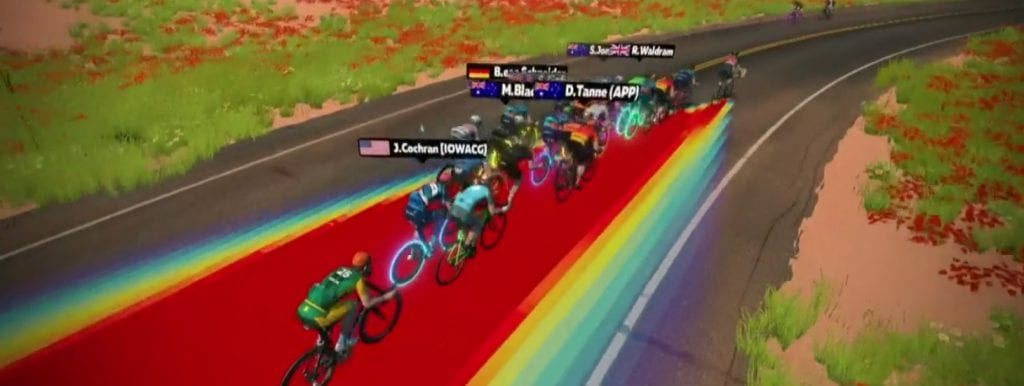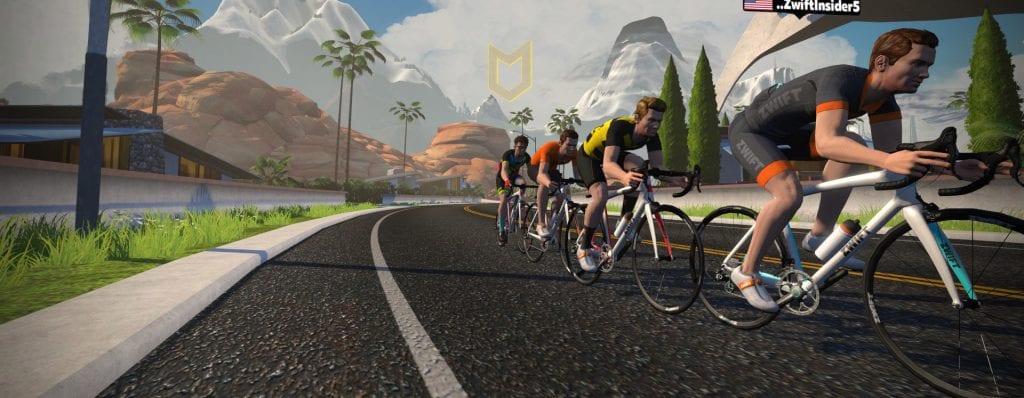UPDATE: the test results below are now outdated, due to Zwift modifying their Pack Dynamics. See the latest version of these tests for accurate data.
Drafting plays a huge role in road cycling and thus was built into Zwift’s physics engine from the early days. Of course, Zwifters (especially racers) have debated the “correctness” of Zwift’s draft since the early days as well!
Perfecting a virtual draft is no mean feat, especially when you consider that there is no way to steer or brake on a trainer (not yet, anyway). Because of these restrictions, Zwift’s draft has a bit of “stickiness” to it, so if you approach a rider from behind, and your speed is close to theirs, you will get “stuck” in their draft. This allows riders to get into the draft and stay there more easily, but can be a bit annoying when you’re trying to come around another rider.
There are, perhaps, some improvements which could be made to the draft. In the past I’ve advocated for Zwift to let us “feel” the draft by changing resistance based on our draft status. And Zwift themselves implemented “double draft mode” back in 2018 – an optional event mode which increases the draft effect substantially so it’s more in line with outdoor levels. (It’s still used in some events to help groups stay together, but racers have found that it makes races less exciting since it raises overall pack speeds, making it more difficult for attacks to stick.)
We had already done some testing of the draft effect, but only with two riders. Our initial draft tests showed a wattage savings of approximately 25% when drafting behind a single rider. We also looked at draft savings up climbs and down descents. But what everyone really wants to know is how the draft behaves in larger groups! How much power am I saving if I’m riding 5th wheel, instead of 2nd? What’s the most efficient power plan for a team time trial?
Here’s a screenshot I grabbed from a recent GCN race broadcast. It shows a special secret “draft viewing mode” – fascinating! But just how powerful is that draft?

It’s much harder to test the group draft, because you have to have multiple Zwift accounts set up, each on separate machines, and be able to control each rider individually on a flat course without interference from outdoor riders. Zwift certainly has ways to do this internally, but for the rest of us mortals it means cobbling together a lot of Zwift accounts, computers, and ANT sticks… then figuring out a way for just those accounts to ride by themselves!
That last bit was the sticky part for us – there was no way to hold a “private” group ride, until Zwift released “Meetup-Only View” this week. Now we can arrange a Meetup on any Zwift course, and only have those we invite visible. Perfect! Let’s test the group draft!
Test Goals
This initial group test set out to answer just two questions:
- Is it more efficient to ride in a standard TTT format (single-file line), or for riders to simply hold high power and “churn” continually on the front like we see in most Zwift races?
- If it’s more efficient to ride single-file, what sort of power savings occurs in each successive rider in a typical TTT formation?

Test Parameters
All of the test riders were set to 183cm height, 75kg weight, and rode Zwift Carbon bikes with 32mm Zwift wheels.
Interesting side-note: Zwift’s draft effect actually takes rider height and weight into account – similar to outdoors! So a taller rider will create a stronger draft than a shorter rider, and a heavier rider a stronger draft than a light one. Zwift computes an estimate of a rider’s frontal area and uses this to compute the wind resistance they encounter, as well as the draft “wake” they produce.
Test Methodology
Tests were done in “Meetup-Only View” on Watopia’s Tempus Fugit route because it’s the flattest on Zwift, and it has a timed section (Fuego Flats Reverse, 4.4 miles long) which could be used to measure the speeds of each test formation.
All of the tests were done with four riders. Because I ran out of ANT sticks and computers!

Tests and Results
Test 1
- All riders @ 300W
Segment time 10:14.8
Speed: 41.34 kph (25.64 mph)
Notes:
- All four riders continually “churned” on the front, alternating between poking their nose into the wind, then getting slowed so another rider could come around to the front. This is what you typically see at the front of a non-TT Zwift race.
Test 2
The second test had the lead rider holding 300W, with the other three riders in single file behind, holding the minimum wattage possible to stay in formation. This is what you would see in an outdoor team time trial:
- Rider 1 @ 300W, Rider 2 @231W, Rider 3 @ 205W, Rider 4 @ 199W
Segment time: 10:47.7
Speed: 39.24 kph (24.34 mph)
Notes:
- The “minimum wattages” stated for riders 2-4 on this test and other tests below should be considered approximations, as it is impossible to figure out the precise wattage required to hold formation due to Zwift’s dynamic physics engine and very small undulations in terrain, even on Fuego Flats.
- Riders received power savings of 23%, 32%, and 34%. So the more riders you’re behind, the bigger the draft effect.
- In a TTT situation with all riders taking equal pulls on the front at these wattages, each rider would average 234W.
- Test 2’s segment time was 23.1 seconds slower than Test 1’s, despite riders holding no higher than 300W in both tests. This may seem odd at first, but it’s a well-known result of the way Zwift’s physics engine works at the front of packs. In the “churn”, riders are speeding up while in the draft, then shooting ahead into the wind, only to be slowed and have another rider shoot past them. This little speed boost accounts for a significant time difference, as we see here!
Test 3
Next, I tried to guess what wattage the lead rider would need to hold in order to beat the time set by the churning group of 300W monsters from test 1. I settled on 320 watts – here are the results:
- Rider 1 @ 320W, Rider 2 @244W, Rider 3 @ 225W, Rider 4 @ 209W
Segment time: 10:22.4
Speed: 39.83 kph (25.33 mph)
Notes:
- Riders received power savings of 24%, 30%, and 35% (2nd, 3rd, and 4th rider respectively). This lines up with the power savings seen in other tests.
- In a TTT situation with all riders taking equal pulls on the front at these wattages, each rider would average 250W.
- This group didn’t quite beat the 300W churn, but it was close.
Test 4
This time around I wanted to make sure we beat the 300W churn group. So I bumped the lead rider up to 350W:
- Rider 1 @ 350W, Rider 2 @270W, Rider 3 @ 244W, Rider 4 @ 235W
Segment time: 10:01.2
Speed: 42.28 kph (26.23 mph)
Notes:
- Riders received power savings of 23%, 30%, and 33% (2nd, 3rd, and 4th rider respectively). This lines up with the power savings seen in other tests.
- In a TTT situation with all riders taking equal pulls on the front at these wattages, each rider would average 275W. This is crucial to understand: that even with Zwift’s “speed churning” from test 1, the four riders in this test significantly beat test 1’s time by riding efficiently in single file formation.
Test 5
For the fifth test, I bumped power up to around the max we might see in a TTT. I also wanted to see how the power savings (in terms of %) changed with higher power on the front:
- Rider 1 @ 400W, Rider 2 @306W, Rider 3 @ 277W, Rider 4 @ 261W
Segment time: 9:31.9
Speed: 44.44 kph (27.57 mph)
Notes:
- Riders received power savings of 23.5%, 31%, and 35% (2nd, 3rd, and 4th rider respectively). This lines up with the power savings seen in other tests.
- In a TTT situation with all riders taking equal pulls on the front at these wattages, each rider would average 311W. So just 11 watts higher than all riders held in test 1: but much, much faster due to smart use of drafting efficiency!
Test 6
For the final test, I reduced power down to the 3 w/kg line, where many D and C riders may ride a TTT effort:
- Rider 1 @ 225W, Rider 2 @173W, Rider 3 @ 156W, Rider 4 @ 144W
Segment time: 11:57.9
Speed: 35.4 kph (21.96 mph)
Notes:
- Riders received power savings of 23%, 31%, and 36% (2nd, 3rd, and 4th rider respectively). This lines up with the power savings seen in other tests.
- In a TTT situation with all riders taking equal pulls on the front at these wattages, each rider would average 175W.
Conclusions
Power savings in a single file line of riders is quite consistent in terms of a percentage, even when the front rider’s wattage varying from 225-400W in the tests. Savings for the 2nd rider ranged from 23-24%, 3rd rider 30-32%, and 4th rider 33-36%.
Clearly, the single-file TTT formation is the most efficient way to travel in a group on Zwift. Racers competing in TTT competitions would be smart to practice riding in formation with a focus on holding that minimum wattage needed to stay on the wheel of the rider ahead. This is more challenging on Zwift compared to outdoors due to delayed response times and a lack of steering/braking, but riders can become very proficient with practice. And that will pay off in a big way in terms of TTT race results!
Your Comments
Got comments or questions? Share below!

